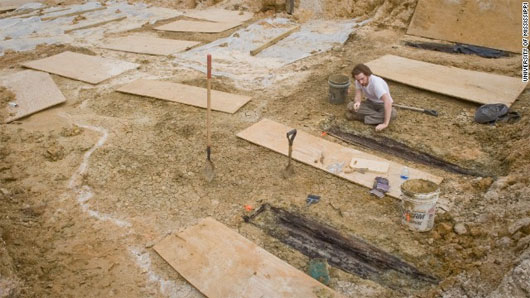Awaken 2,000 forgotten tombs in the US
Underneath the grass and dust next to the trees on the campus of the University of Mississippi Medical Center (Mississippi, USA), part of the history of the United States is gradually being revealed with 2,000 unidentified graves.
There have been rumors of being somewhere in the underground at the Medical Center, which was once the site of the Mississippi State Psychiatric Hospital, there exists a cemetery. But history has long been lost to its exact position. That's why rumors continue to spread until 2,000 unidentified tombs are discovered one day.
In February this year, in a survey serving the campus expansion project at the University of Mississippi Medical Center, surveyors found dozens of sarcophagus waves lying in line, Among them were coffins a few inches from the ground. Almost immediately, the construction plan at the site was postponed and the question was what would people do with each grave?

An estimated 2,000 graves were discovered at the University of Mississippi Medical Center.(Photo: CNN)
This is not the first time such graves have been discovered in the United States when contractors began digging through vacant land and found forgotten graveyards over time. But the scale of discovery at the University of Mississippi, one of the largest graveyards discovered in recent years, has led many to wonder who these remains belong to?
According to the memory of those who know the story, the workmen and construction contractors find simple pine boxes containing the remains of the Medical Center campus often occur. The number of skeleton boxes discovered was four, five or six. According to Jack Mazurack, a spokesman for the medical center, during the 1990s, while building a laundry facility, construction workers found about 40 unidentified graves. But last year, in the process of conducting a project to upgrade a road within the Medical Center campus, 66 coffins were discovered.
Along with the appearance of forgotten coffins in the ground, many people began to rumor that these coffins contained remains of those who had abandoned their lives or slaves in the American civil war. From an academic perspective, experts disagree with this information. Historical data reveals that the area was not a major battleground in the civil war, and there were no indications in the state's historical archives indicating that there was a graveyard of slavery that existed. here.
For in-depth research on this issue, the University of Mississippi Medical Center previously collaborated with a team of anthropology, Mississippi University led by Professor Nicholas Hermann to carry out the task. move the remains, conduct inspections. Almost immediately, Hermann's team thought that the remains discovered here had a connection with the Psychiatric Hospital that was present in this area in 1855.
'We guess that because there are no personal belongings, no clothes, not even any buttons or pins, so maybe these core cards are for those who treat at mental hospital . According to that speculation, these remains appeared around the mid to late 19th century to early 20th century , "said Derek Anderson, an archaeologist from the research team.
In the past, Mississippi State Psychiatric Hospital used to be a place where patients had many different diseases in the state for treatment. According to records, many people stay in treatment for a period of many years. And when they died, only a few were picked up by the family. Experts believe that poverty can be one of the reasons for this because families at the time did not have the financial ability to take back the body of their loved ones and bring them to burial. As a result, many people were buried in unidentified tombs in the area believed to be the graveyard of the mental hospital. The harsh time passed and the trail of the graveyard also disappeared every day.
In the process of studying the remains of the 66 tombs discovered last year, Professor Hermann said that once the inspection process was completed, the remains would be buried in the cemetery of the Medical Center. sacrifice. He believed that finding these tombs was just the beginning and said that studying the remains would help reveal the homeland of the deceased and why they died, thereby doing so. sheds light on a part of history as well as methods of treating diseases in Mississippi state from the late 19th century to the early 20th century.
In the immediate future, because of the excavation and burial of up to 2,000 remains that will cost millions of dollars, the University of Mississippi Medical Center decided to leave the deceased 'dormant' and seek other solutions for extend.
- Decode huge ancient tombs of 2000 year old stone
- Ancient tombs of thousands of years carry the form of 'dead boat'
- Egypt discovered tombs from ancient Rome
- 6000 year old grave is the first telescope in the world?
- Excavation of the 2 most exotic Egyptian tombs in history: after 4000 years, the paint is still new
- Excavated more than 200 3,000-year-old tombs in China
- Egypt discovered 10 tombs of 2,500 years filled with mummies
- Dog sniffing discovered 6 tombs 3,000 years old
- Discover the mysterious tomb without any corpse
- Tomb of 25,000 years old in Russia
- Khai excavated an ancient tomb for 300 years in Hanoi
- China excavated the tomb of the Liao dynasty dating back 1000 years
 Discovered an ancient centipede fossil 99 million years old
Discovered an ancient centipede fossil 99 million years old Discovered bat-like dinosaurs in China
Discovered bat-like dinosaurs in China Discovered a 200-year-old bronze cannon of the coast
Discovered a 200-year-old bronze cannon of the coast Discover 305 million-year-old spider fossils
Discover 305 million-year-old spider fossils